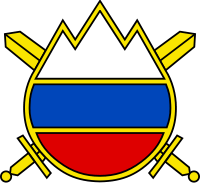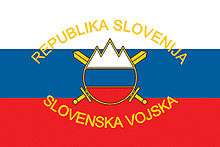Slovenian Armed Forces
| Slovenian Armed Forces Slovenska vojska | |
|---|---|
|
Slovenian Army emblem | |
|
Flag of the Slovenian Army | |
| Founded | 1991 |
| Service branches |
Slovenian Ground Force Slovenian Air Force and Air Defence Slovenian Navy |
| Headquarters | Ljubljana |
| Leadership | |
| Commander-in-Chief | Borut Pahor (president of Slovenia) |
| Minister of Defense | Andreja Katič |
| Chief of Defense | Andrej Osterman (Major General) |
| Manpower | |
| Military age | 18 |
| Conscription | Abolished in 2003 |
| Available for military service | 496,929, age 17 (voluntary) (2005 est.) |
| Fit for military service | 405,593, age 17 (voluntary) (2005 est.) |
| Reaching military age annually | (2005 est.) |
| Active personnel | 7,300 (professional soldiers) (ranked 123rd) |
| Reserve personnel | 1,500 (contract reserve soldiers) |
| Expenditures | |
| Budget | €378,575,978 (2013)[1] |
| Percent of GDP | 1.02% (2013)[2] |
| Related articles | |
| History |
Slovenian War of Independence Slovenian Territorial Defence |
| Ranks |
Slovenian military ranks Anthem of the Slovenian Army |
The Slovenian Armed Forces or Slovenian Army (Slovene: Slovenska vojska; SAF/SV) are the armed forces of Slovenia. Since 2003, it is organized as a fully professional standing army. The Commander-in-Chief of the SAF is the President of the Republic of Slovenia (Borut Pahor), while operational command is in the domain of the Chief of the General Staff of the Slovenian Armed Forces, the position being held since October 2014 by brigadier Andrej Osterman.
History
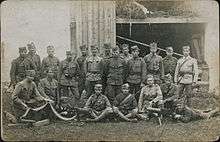
The military history of Slovenia spans less than a hundred years. Following the disintegration of the Austrian-Hungarian Empire at the end of World War I, the Duchy of Styria was divided between the newly established states of German Austria and the State of Slovenes, Croats and Serbs. Rudolf Maister, a Slovene major of the former Austro-Hungarian Army, occupied the town of Maribor in November 1918 and claimed it to the State of Slovenes, Croats and Serbs. After a short fight with German Austrian provisional units, the current border was established, which mostly followed the ethnic-linguistic division between Slovenes and ethnic Germans in Styria.
The current Slovenian Armed Forces are descended from the Slovenian Territorial Defence (Teritorialna Obramba Republike Slovenije; or Slovene TO), formed in 1991 by fusion of Territorial Defence (formed in 1968 as a paramilitary complement to the regular army of the former Yugoslav within the territory of Slovenia) with secret alternative command structure, known as the Manoeuvre Structures of National Protection (Manevrska struktura narodne zaščite, or MSNZ), which was an existing but antiquated institution, (unique to Slovenia), intended to enable the republic to form an ad hoc defence structure, akin to a Home Guard. It was of negligible importance prior to 1990, with antiquated weapons and few members.
When Slovenia declared independence at the onset of the Yugoslav Wars in 1991, the Slovenian Territorial Defence and the Slovenian police comprised the majority of forces engaging the Yugoslav People's Army during the Ten-Day War. The Slovenian Armed Forces were formally established in 1993 as a reorganization of the Slovenia Territorial Defence.
Current status
After 1993, the Slovenian Armed Forces had relied on mandatory military service, with conscripts receiving 6–7 months of training. In 2003, the Slovenian Government abolished conscription and as of July 2004, the Slovenian Armed Forces had been almost completely reorganised into a professional army now based on volunteers. Currently there are approximately 7,300 active troops and approximately 1,500 in reserve, reduced from 55,000 personnel during conscription.
A major reorganization of the Slovenian Armed Forces is currently underway[3] with a goal making them more effective and cheaper. More than half of all commands have been disbanded which has made commanding the subordinated units easier and faster. Soldiers are to be located nearer to their homes in order to minimize travel costs. Since the Slovenian Armed Forces do not have enough modern armored vehicles to maintain three motorized battalions fulfilled at every time, one Wheeled Combat Vehicles Company and one Tank Company have been organized within the Logistics brigade, which now lends vehicles to any of four newly formed infantry regiments, regarding to the regiments' needs. Reorganization also transformed 72nd Brigade from a support unit to a combat unit and thus equaled it with the 1st Brigade. Both brigades were added support elements, such as Air Defense, Artillery, Intelligence, etc. The operational units now consist of Special Operations Unit, Naval Division, an Aviation Regiment and three brigades, the 1st (responsible for western Slovenia), 72nd (responsible for eastern Slovenia) and Logistics Brigade.
NATO membership

As part of the former Socialist Federal Republic of Yugoslavia, Slovenia was never a member of the Warsaw Pact. Today, the foreign policy priority of NATO membership drives Slovenia's defense reorganization. Once many countries lifted the arms embargo on Slovenia in 1996, the country embarked on a military procurement program to bolster its status as a NATO candidate and to aid its transformation into a mobile force. Active in the SFOR deployment in Bosnia and Herzegovina, Slovenia is also a charter member of Partnership for Peace and a regular participant in PfP exercises. The United States provides bilateral military assistance to Slovenia, including through the International Military Education and Training (IMET) program, the State Partnership Program (aligned with Colorado), and the EUCOM Joint Contact Team Program.
Slovenia formally joined NATO in March 2004.[4] The transition of its armed forces from a primarily conscript-based territorial defense organization to a professional force structure has the ultimate goal of creating NATO-interoperable combat units able to operate on an even par with units from other NATO armies. Implementation of interoperability objectives as determined by the Planning and Review Process (PARP) and the Individual Partnership Program (IPP) as part of Slovenia's PfP participation proceeds. Slovenia's elite units already train with and are integrated into international units including NATO members—for example as part of SFOR and on Cyprus. Its elite mountain troops will be assigned to the Multinational Land Force peacekeeping battalion with Italy, Hungary, and Croatia. Slovenia hosted its first PfP exercise in 1998--"Cooperative Adventure Exchange"—a multinational disaster-preparedness command post exercise involving almost 6,000 troops from 19 NATO and PfP member nations.
Slovenian soldiers are a part of international forces serving in Bosnia and Herzegovina, Kosovo, Afghanistan,[5] Iraq, Chad, Lebanon. They have also served in Cyprus and the Golan Heights as a part of UNFICYP and UNDOF respectively.
Slovenia hosts Multinational Centre of Excellence for Mountain Warfare (MN COEMW; Slovene: Večnacionalni center odličnosti za gorsko bojevanje), one of NATO Centres of Excellence, located in Bohinjska Bela, Slovenia. It is "responsible for training individuals and units for operation in the mountains and other terrains difficult to pass".[6]
Organization

The Slovenian Armed Forces are organized as single-branch armed forces with the army as their primary component. The personnel is divided into three categories:
- professional soldiers (full-time soldiers)
- contract reserve soldiers (serve up to 30 days per year)
- voluntary recruits (basic training)
Commands and units
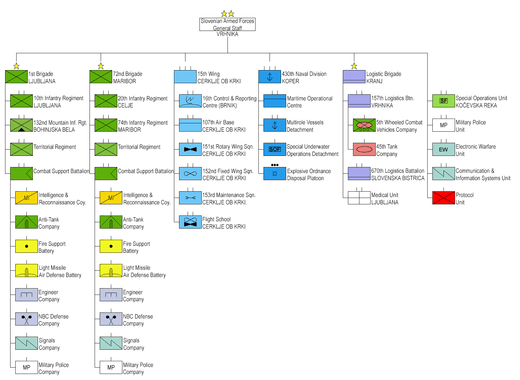
- General Staff of the Slovenian Armed Forces
- Verification Centre
- Support Unit
- Military Police Unit
- Electronic Warfare Unit
- Unit for Communication and Information Systems
- Military Orchestra
- Protocol Unit
- Sports Unit
- Joint Operational Centre
- Situation Monitoring Section
- Movement Coordination Section
- Operations Management Section
- Support Branch
- Military Schools Centre
- Command and Staff School
- Officer Candidate School
- Non-Commissioned Officer School
- School of Foreign Languages
- Skills Centre
- Library and Information Centre
- E-Learning Section
- Military Museum
- Special Operations Unit
- Company for Special Operations
- Combat Service Support Company
- Special Operations Training Centre
- 1st Brigade
- 10th Infantry Regiment
- 132nd (Mountain) Infantry Regiment
- Branch Battalion
- Light Rocket Air Defense Battery
- Engineer Company
- Nuclear, Biological, Chemical Defense Company
- Signals Company
- Military Police Company
- Intelligence and Reconnaissance Company
- Fire Support Battery (Artillery)
- Anti-Tank Company
- Territorial Regiment
- 72nd Brigade
- 20th Infantry Regiment
- 74th Infantry Regiment
- Branch Battalion
- Light Rocket Air Defense Battery
- Engineer Company
- Nuclear, Biological, Chemical Defense Company
- Signals Company
- Military Police Company
- Intelligence and Reconnaissance Company
- Fire Support Battery (Artillery)
- Anti-Tank Company
- Territorial Regiment
- Logistics Brigade
- Medical Unit
- 157th Logistics Regiment
- 5th Wheeled Combat Vehicles Company
- 45th Tank Company
- 670th Logistics Regiment
- 15th Wing (Military Aviation Regiment)
- 151st Rotary Wing Squadron
- 152nd Fixed Wing Squadron
- 153rd Aircraft Maintenance Squadron
- 107th Air Base
- 16th Air Space Control and Surveillance Centre
- Flight School
- 430th Naval Division (Regiment)
- Maritime Operational Centre
- Multirole Vessels Detachment
- Special Underwater Operations Detachment
- Explosive Ordnance Disposal Platoon
Military airports (Slovenian army)
The Slovenian army currently maintains one military airport Cerklje ob Krki near town of Brežice. The airport's official name is Cerklje ob Krki Airbase.
The others that are partially military are:
- Ljubljana Airbase shares the airport with Ljubljana International Airport 1x helicopter Bell 412 is stationed there for mountain rescue
Barracks
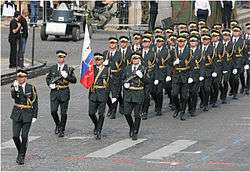
International cooperation
Slovenia is part of NATO and the European Union. The Slovenian Armed Forces have participated and presently participate in many aspects of both organizations.
| Current Mission and/or Operation | Country | Organization | Nr. of personnel |
|---|---|---|---|
| ISAF | Afghanistan | NATO | 7 |
| Joint Enterprise | Bosnia and Herzegovina | NATO | 4 |
| ALTHEA | Bosnia and Herzegovina | European Union | 9 |
| KFOR | Kosovo | NATO | 306 |
| Joint Enterprise | Republic of Macedonia | NATO | 1 |
| Joint Enterprise | Serbia | NATO | 1 |
| EUTM | Mali | European Union | 4 |
| Operation Atalanta | Italy | / | 7 |
| UNIFIL | Lebanon | United Nations | 14 |
| UNTSO | Syria | United Nations | 3 |
| Former Mission | Operation | Country | Organization | Nr. of personnel | Time |
|---|---|---|---|---|---|
| ALBA | Operation Sunrise | Albania | OSCE | 21 | May–July 1997 |
| UNFICYP | / | Cyprus | United Nations | 29 | September 1997–June 2001 |
| ALBA | Operation Allied Harbour | Albania | NATO | 26 | May–July 1999 |
| UNMIK | / | Kosovo | United Nations | 1 | October 1999–December 2001 |
| OHR | / | Bosnia and Herzegovina | United Nations | 1 | July 2001–January 2003 |
| ? | Operation Concordia | Republic of Macedonia | European Union | 1 | March 2003 |
| Kosovo Force | Operation Joint Guardian | Kosovo | NATO | 11 | November 2003–May 2004 |
| / | Nato support to Pakistan | Pakistan | NATO | 2 | November 2005–January 2006 |
| International military exercises | Country | Organization | Nr. of personnel | Time |
|---|---|---|---|---|
| Cooperative Nugget 1997 | Fort Polk, U.S. | Partnership for Peace/NATO | 1997 | |
| Cooperative Adventure Exchange '98 | Slovenia | NATO | 1998 | |
| Cooperative Key 2002 | 2002 | |||
| Cunning Wassel 2002 | 2002 | |||
| Clever Ferret 2003 | 2003 | |||
| Elite 2003 | 2003 |
Gallery
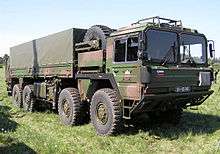 Slovenian MAN Army Truck
Slovenian MAN Army Truck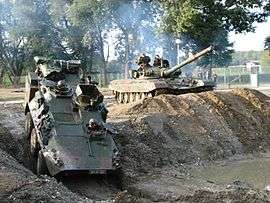 Slovenian Armoured Vehicles
Slovenian Armoured Vehicles Slovene Army Humvee on patrol in Kosovo
Slovene Army Humvee on patrol in Kosovo Slovenian Convoy in Kosovo KFOR Mission
Slovenian Convoy in Kosovo KFOR Mission AS AL 532 Cougar of the Slovenian Air Force
AS AL 532 Cougar of the Slovenian Air Force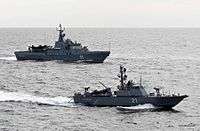 10412 class patrol boat Triglav with Super Dvora Mk II-class patrol boat Ankaran
10412 class patrol boat Triglav with Super Dvora Mk II-class patrol boat Ankaran
References
- ↑
- ↑
- ↑ http://www.mo.gov.si/fileadmin/mo.gov.si/pageuploads/pdf/ministrstvo/SOPR2013_2018.pdf
- ↑ http://www.nato.int/docu/update/2004/03-march/e0329a.htm
- ↑ The Slovenia Times - Daily News Archived 14 June 2011 at the Wayback Machine.
- ↑ Slovenian Armed Forces. "Multinational Centre of Excellence for Mountain Warfare". Slovenian Armed Forces. Retrieved 28 January 2012.
Further reading
- Furlan, Branimir (2013). "Civilian Control and Military Effectiveness: Slovenian Case," Armed Forces & Society 39, No. 3, pp. 434–449.
External links
| Wikimedia Commons has media related to Slovenian Armed Forces. |
- Official page (English)
- Slovenian Ministry of Defence official site (English)
- Slovenian Air Force
- Slovenian Armed Forces/Slovenska vojska
